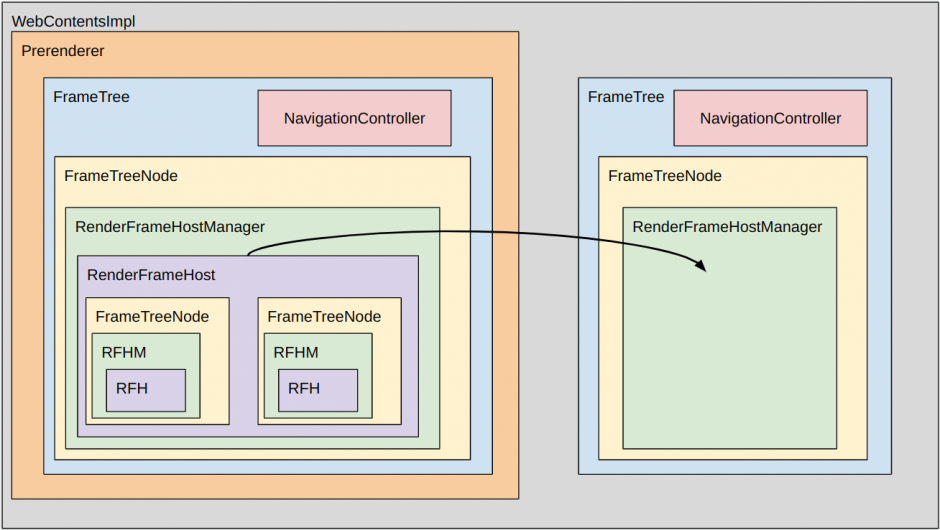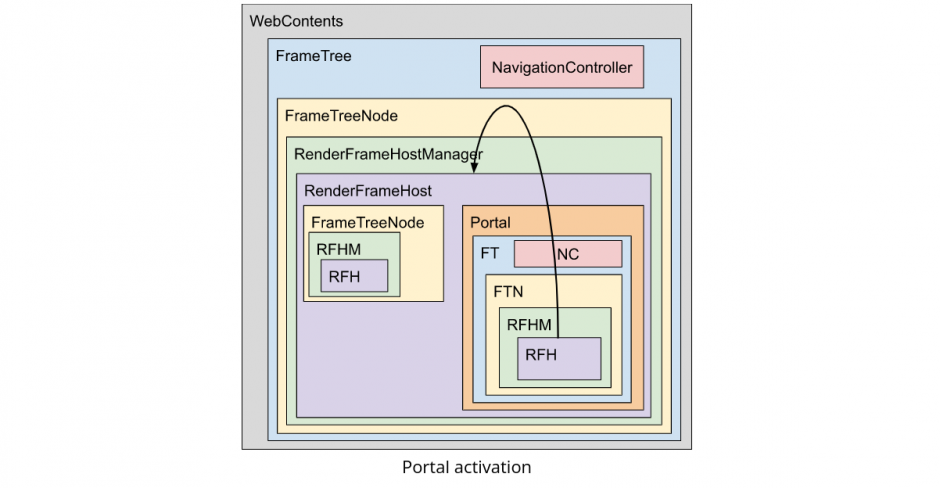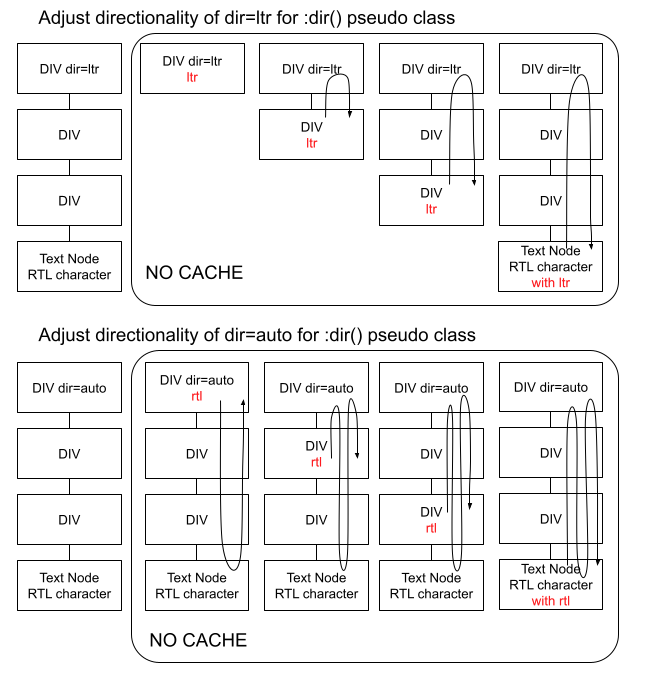FrameTreeNode from RenderFrameHost on the MPArch project.
Relationship between FrameTreeNode and RenderFrameHost in MPArch
The main frame and iframe are mirrored as FrameTreeNode and the document of each frame is mirrored as RenderFrameHost. Each FrameTreeNode has a current RenderFrameHost, which can change over time as the frame is navigated.
Let’s look at the relationship between FrameTreeNode and RenderFrameHost of features using the MPArch structure.
BFCache
BFCache (back/forward cache) is a feature to cache pages in-memory (preserving javascript state and the DOM state) when the user navigates away from them.
RenderFrameHost, is saved in BFCache, and when the back/forward action occurs, RenderFrameHost is restored from BFCache. The FrameTreeNode is kept when RenderFrameHost is saved/restored.
Prerendering
Prerender2 is a feature to pre-render the next page for faster navigation. In prerender, a document will be invisible to the user and isn’t allowed to show any UI changes, but the page is allowed to load and run in the background.
Navigation changes to support multiple pages in WebContents
When the prerendered page is activated, the currentRenderFrameHost that FrameTreeNode had is replaced with RenderFrameHost in Prerender.
Fenced Frame
The fenced frame enforces a boundary between the embedding page and the cross-site embedded document such that user data visible to the two sites is not able to be joined together.
FrameTreeNode in FrameTree, and the fenced frame can be accessed through a delegate.
GuestView & Portals
Chromium implements a tag with a GuestVIew which is the templated base class for out-of-process frames in the chrome layer.
For more detail, please refer to Julie’s blog.
Portals allow the embedding of a page inside another page, which can later be activated and replace the main page.
Navigation changes to support multiple pages in WebContents
The GuestView and Portals are implemented with a multiple
WebContents model and considering refactoring to MPArch.
Pending Deletion
When
RenderFrameHost has started running unload handlers (this includes handlers for the unload, pagehide, and visibilitychange events) or when RenderFrameHost has completed running the unload handlers, RenderFrameHost‘s lifecycle is in the pending Deletion.
Reference FrameTreeNode from RenderFrameHost
Accessing FrameTreeNode from RenderFrameHost that enters BFCache, accessing FrameTreeNode from old RenderFrameHost that has already been swapped from the prerendered page, or accessing FrameTreeNode in the pending deletion status all have security issues. Currently, RenderFrameHost has direct access to FrameTreeNode internally and exposed methods to allow access to FrameTreeNode externally.
A meta bug 1179502 addresses this issue.
Introduce
RenderFrameHostOwner
RenderFrameHostOwner is an interface for RenderFrameHost to communicate with FrameTreeNode owning it which can be null or can change during the lifetime of RenderFrameHost to prevent accidental violation of implicit “associated FrameTreeNode stays the same” assumptions.
RenderFrameHostOwner is, // - Owning FrameTreeNode for main RenderFrameHosts in kActive, kPrerender,
// kSpeculative or kPendingCommit lifecycle states.
// - Null for main RenderFrameHosts in kPendingDeletion lifecycle state.
// - Null for main RenderFrameHosts stored in BFCache.
// - Owning FrameTreeNode for subframes (which stays the same for the entire
// lifetime of a subframe RenderFrameHostImpl).//content/browser/renderer_host/render_frame_host_impl.h
At all places where
FrameTreeNode is used, we are auditing them if we could replace FrameTreeNode with RenderFrameHostOwner after checking what lifecycle states of RenderFrameHost we can have. However, there are still some places that are not available to use RenderFrameHostOwner (e.g. unload handler). We are still investigating how to deal with these cases. It would be necessary to refactor for RenderFrameHost::frame_tree_node(), which is widely used inside and outside RenderFrameHost, and that work is ongoing.








